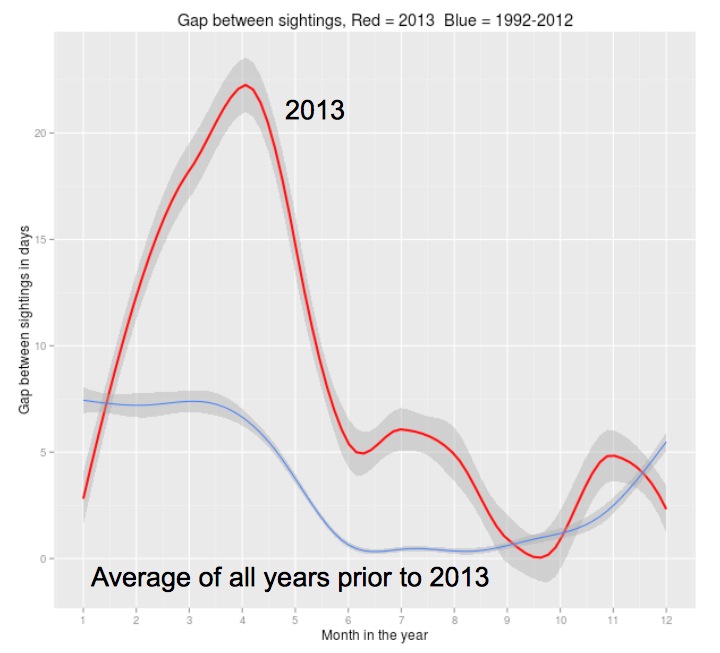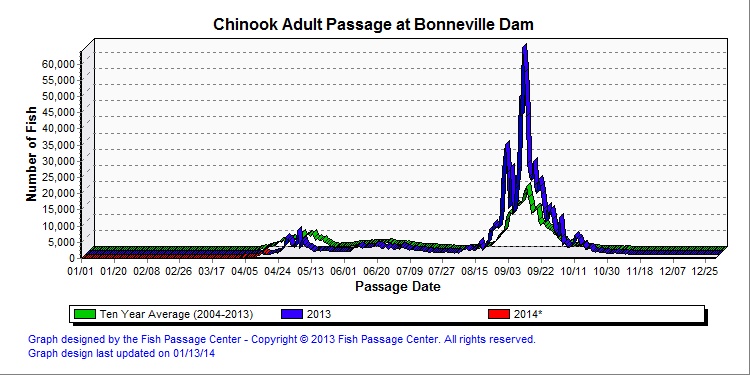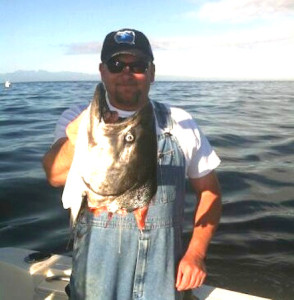The year 2013 was an exceptionally unusual one in the world of southern resident killer whales and Pacific salmon. Most noticeably, the southern residents returned to the Salish Sea later than normal, raising concerns among conservationists. Throughout the summer, researchers and whale watch operators noted that the whales were present less than normal and the duration of their visits to the Salish Sea were abbreviated.
Meanwhile, the Chinook salmon runs on the Fraser plummeted while 80-year record returns were counted on the Columbia at the Bonneville dam fish ladder. Combined with new evidence from satellite tags that the southern residents are focused on Columbia salmon during the spring months, the sighting patterns of 2013 may indicate a transition for the urban estuary known as the Salish Sea — from one with “resident” orcas to one with southern “transient” fish-eating orcas.
Killer whale trends
Based on data from the Orca Network sighting maps from the past decade (see figure below), records were set or tied in 2013 for the least number of days spent by southern residents in the historic core of their summer habitat (the west side of San Juan Island in Haro Strait). The SRKWs were seen only once in March and not at all in April. Even more shockingly, they showed up only 5 times in May (a record low) and were observed 15 times in June, a low level not seen since 2001.

The same data show downward trends in monthly sightings over the last decade. With the exception of a high in 2011, the March prevalence has been flat or decreasing. There are stronger, more continuous downward trends in April and May sightings.

We used the OrcaMaster database maintained by The Whale Museum to look for trends in sighting “gaps” — the number of consecutive days between sightings of J pod members within the Salish Sea.  Val plotted running averages of 2013 gaps versus a historic average (1992-2012) and found that in the spring of 2013 sighting gaps were 2-5x longer than the average. Only during and after September of 2o13 did the gap return to a normal duration. (Maybe we should look at trends in Salish Sea chum run?)

Historic trends in J pod sighting gaps (Val Veirs, using R and ggplot)
Chinook trends
One way to characterize the foraging conditions the SRKWs experienced in 2013 within the Salish Sea and on the outer coast is to examine the Chinook salmon counts from the Fraser and Columbia rivers. The Albion test fishery on the Fraser provides a proxy for the abundance of Fraser Chinook, the primary prey of SRKWs in the Salish Sea from spring through the summer (Hanson, Baird, Ford, Hempelmann-Halos, Van Doornik, Candy, Emmons, Gregory Schorr, Brian Gisborne, Katherine Ayres, Samuel Wasser, Kelley Balcomb-Bartok, John Sneva and Michael Ford, 2010). The fish counts at the Bonneville dam on the Columbia are a proxy for the abundance of Chinook on the outer coast of Washington.
As marine naturalists like Jane Cogan and Monika Wieland have pointed out, 2013 was an exceptionally bad year for Fraser Chinook returns. The fish arrived late and the cumulative returns were well below this historic average and only slightly better than in the worse year on record, 2012. The highpoint of the 2013 run was the peak around the 3rd week of August that may also be related to a pulse of Chinook recorded in the first two weeks of July off southern Vancouver Island (in the Area 20 test catch fishery).


In contrast, adult and jack Chinook abundance in the Columbia River has been on the rise for the past couple decades, with 2013 standing out as a record-setting year for adult Chinook.
 Daily Chinook counts at Bonneville show that while most of the record-setting abundance was due to the fall run, the spring run also had peaks well above the 10-year average.
Daily Chinook counts at Bonneville show that while most of the record-setting abundance was due to the fall run, the spring run also had peaks well above the 10-year average.

The spring run passed Bonneville from late April to late May, 2013. This timing is consistent with the timing of the spring Columbia Chinook run in 2012. Since Bonneville dam is about 200 km upstream from the river mouth and adult Chinook swim at about 0.5 m/s, we could expect that the returning Columbia Chinook were in the ocean at least until about a week before they reached Bonneville ( 200,000 m / 0.5 m/s = 400,000 seconds = ~5 days). So where were the southern residents in March and April of 2013, since they weren’t being sighted in the Salish Sea? We don’t know about J and L pods, but the satellite tag deployed on K25 indicates the likely position of K pod (up until April 4).
The answer is: during March, 2013, K25 was spending a lot of time going back and forth along the continental shelf of Washington (and to a lesser extent Oregon) with a track that centered on the mouth of the Columbia River.
We need to know more about when the returning Columbia fish are on the continental shelf and accessible to the southern resident killer whales. But these salmon trends from the region’s biggest rivers combined with migratory patterns of the orcas strongly suggest that the southern resident killer whales may be happy to move their “residence” to wherever the eating is best! Perhaps we are watching them become southern transient fish-eating killer whales?!
Anecdotal observations of orca-salmon interactions
When the fish-eaters were around during the summer of 2013, they displayed some unusually aggressive foraging. A (potential) prize Chinook salmon was taken off a derby fisherman’s line and became the focus of a KPLU radio story and an impressive photo of the one that was eaten away…

The part that didn’t get (taken) away. (credit: Kevin Klein)
This local predation event was a first for Washington State (as far as we know), though it was comparable to one by Alaskan fish-eating killer whales. In the video below, the Alaskan whales were foraging amongst fishing vessels and happened (probably visually) upon a large hooked Chinook. (Mute your speakers if you don’t want to hear angry and amazed fishermen cursing.)
Later in the summer of 2013, back in Washington, a whale watch captain obtained this video of southern resident killer whales pursuing a large (likely Chinook) salmon alongside the boat —
Could these uncommon foraging observations indicate that the southern residents were having a tough time finding enough to eat in the Salish Sea? We’d be interested in hearing from local fishers about how often they’ve had fish taken off their lines by Southern Residents. Monika assures us though that it is common to observe SRKWs pursuing salmon around and underneath whale watching boats, so maybe we should attribute the second video to more typical foraging and take it as evidence that orca-salmon interactions in the fall of 2013 were more typical than earlier in the year.
7919
{5THBC54C}
apa-no-doi-no-issue
default
ASC
no
5175
http://www.beamreach.org/wp-content/plugins/zotpress/
Hanson, M. B., Baird, R. W., Ford, J. K. B., Hempelmann-Halos, J., Van Doornik, D., Candy, J., … Michael Ford. (2010). Species and stock identification of prey consumed by endangered southern resident killer whales in their summer range. Endangered Species Research, 11, 69–82.
Read More
Wow, just a few minutes into the first discussion on Monday morning, Kelsey saw killer whales out the window at Lime Kiln State Park. This was a very, very unlikely observation. With such a good omen, I know that we will see and learn much from orcas this spring.
On Tuesday, I ‘lectured’ on an introduction to acoustics — waves, amplitudes, frequencies, decibels and all that jazz. Take a look at the white board —

Looks colorful at least, wouldn't you agree?
After nearly finishing this fun little discussion and demo, I noticed that I had a HUGE ERROR. I had defined decibels directly in terms of signal power but that is WRONG. Decibels are defined in terms of energy or power, and energy and power are proportional to the square of the pressure (true for all linear waves). Take a look at my ugly fix —

Here,in the center, I got the correct definition. Check it out.
It looks a bit like a blue outlined blobby orca, don’t you think? In any case it is right!
Read More
After a fantastic overview of recent research and very current concerns expressed by the commercial whale-watcher industry, Scott and I parted company with the brand new Beam Reach students and their lead instructor, Jason. They took a very rocky ferry ride from Port Townsend across to Whidbey Island. We watched the little white ferry bobbing in the midst of a sea of angry whitecaps and waves.
A few hours later, Scott and I started north on Cat’s Cradle, our 32′ catamaran. With sails reefed and motor running fast and smooth we fought away from Port Townsend with 30 kt winds, 3-6′ waves and an adverse tide. The boat did well and we braved white knuckles and arrived 16 miles north on Lopez Island about an hour after dark. The last miles were done carefully with radar and GPS.
Beam Reach 2009 – Spring Program – BEGINS!


Read More
Beam Reach has made quite a contribution at the Paris 2008 Acoustics Conference. Jason’s report on his elephant footfalls was well received on Monday with his work on new census techniques fitting in well with the many talks on marine acoustics survey techniques. My talk on documenting ‘communication’ between a calf and its mom/brother elicited some good questions and much conversation on just what is conversation anyway afterwards in the halls and at lunch. And Kenna brought Zipf’s slope to the attention of the marine mammal community and she did an excellent job of both presenting and answering the large number of questions that her talk elicited. People came up to me afterwards and said “is she really an undergraduate?
I have talked about Beam Reach with many acousticians here and the 100 or so people in attendance of the marine mammal sessions certainly have seen Beam Reach returning research results to the community. I know that this will enhance the program and I hope that the word about what Beam Reach can accomplish spreads to draw in excited and qualified applicants in tthe future.
Read More
Sunday – Tuesday, September 9-11, 2007
Sunday, Gato Verde docked at the FHL docks and the crew swap began. Lots of students headed toward showers and a bit of distance and 5 eager souls brought loads and loads of food on board. We motored a bit south and anchored in Griffin Bay. That night a ‘heavy breather’ seal entertained us. We listened through two hydrophones and Ash and Sam showed there acuity in accurately determining the bearing of the sounds of objects thrown in various directions. The night was calm and the sunrise elegant.
Where are the whales? We did not know so we talked about methods and then set up a whale pass-by. This was done by putting the underwater speaker in the dinghy and anchoring the dinghy in a little bay on the south side of Lopez. We deployed the array and the high frequency hydrophone and drove around observing the stationary “dinghy-orca”. Then I drove the dinghy at high speed to generate some boat noise. Todd calmly told me on the radio that I should pull up the dinghy’s anchor before taking off. This neat thought came to me as I was zipping along at ~20 kts, anchor flying behind me! It will be good to see just what it takes to ‘analyze’ these data.
Today, Sept. 11, began with long discussions of lots of important ‘stuff’ and mid-morning we set off. Since we didn’t know where the whales were, we let the current draw us toward the sea (Straits of Juan de Fuca). It turned out that Alex’s suggestion that we go toward Race Rocks was prescient. By afternoon, we got reports of J, K, and L pods incoming west of Victoria. Tim and Ann configured a 3-d array by attaching the ‘high-frequency’ hydrophone below the array and everyone worked to get everything in the water and connected to the various computers and recorders. Cameras and protractors and note papers and range-finder were limbered up and THEN, the orcas came. They were spread out and not vocalizing. Later, as we approached San Juan Island, just south of the Lighthouse, vocals began and lots and lots of files were recorded and observations. It will be a huge effort to make any sense of this.
Good luck, Beam Reachers!
Read More
Friday 8/31/07
Fish Creek to Snug Harbor
Winds SW 5-15 knots, light rain in morning
Spent morning measuring source level of Gato Verde main generator. Around noon, started transit to Snug Harbor, looking for KW en route. Sighted some harbor porpoises in Haro Strait on run downwind under screecher.
Read More
This morning, Jason and I showed a number of our research interests and interspersed these with various demonstrations and class activities. It was fun to watch you students sitting with your heads down on your desks and raising your hand when I dropped the audio frequency going into our speakers down below about 19 kHz and putting your hands back down when the frequency went up a bit. All this was far, far above anything I could hear. I know you all can hear very, very well. This bodes well for the course!
I hope that Dr. Stern (our expected evening speaker on Minke whales) got back safely from the sea after his vessels motor failed.
See you tomorrow — let’s cool off!
Read More

Scott’s second baby of the month is born and thriving. Cora was born on August 10th and is such a sweet little baby! And now, Beam Reach is one week old and seems also to be vital and thriving. Congratulations, Scott.
And congratulations to Jason and Donna for such elegant and successful directing of this first week of Beam Reach.
Beam Reachers! I sense your energy and drive — it just exudes. You are launched into a unique intellectual and experiential adventure.
—–
Read More


Daily Chinook counts at Bonneville show that while most of the record-setting abundance was due to the fall run, the spring run also had peaks well above the 10-year average.











 Twitter
Twitter LinkedIn
LinkedIn Facebook
Facebook